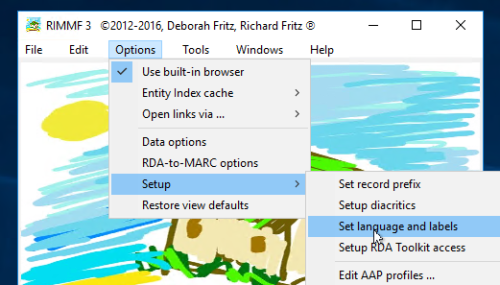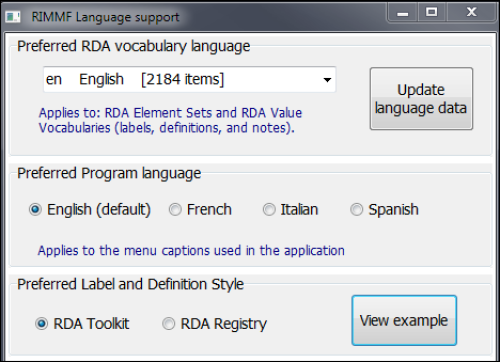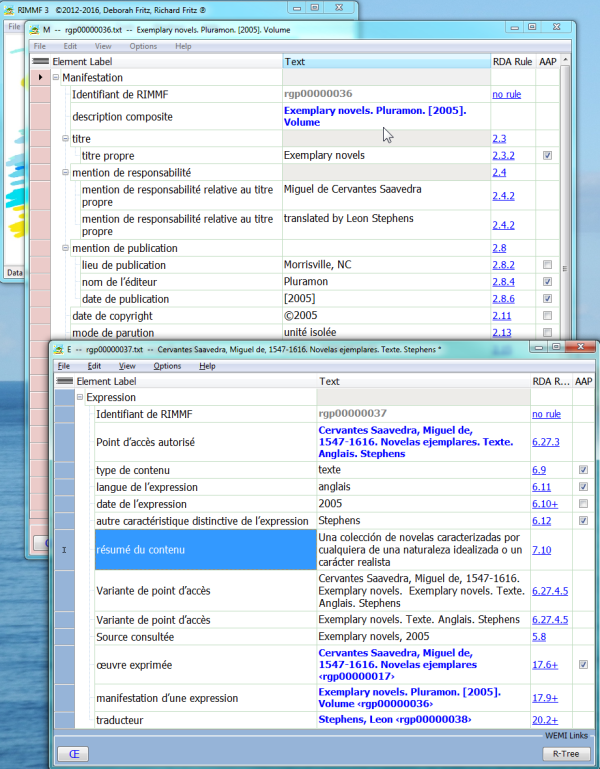Table of Contents
Language support in RIMMF3
Highlights (most recent first)
- Finnish and Norwegian labels and definitions for entity elements and value vocabularies, as of RDA Registry version 2.7.2.
- Value vocabulary terms in Catalan, Norwegian, Swedish and Vietnamese, as of RDA Registry version 2.7.1.
- Danish and German labels and definitions for entity elements and value vocabularies, as of RDA Registry version 2.7.1.
- Vietnamese labels and definitions for Work, Manifestation, and Expression elements, as of RDA Registry version 2.7.1.
- Greek labels and definitions for the Agent class, as of RDA Registry version 2.7.0.
- Program menus available in Italian, beginning with RIMMF release 161024.
- Value vocabulary terms in French, Spanish, Chinese, Dutch, Italian, German, Finnish and Hebrew, as of RDA Registry version 2.5.2.
- Program menus available in French and Spanish, beginning with RIMMF release 160328.
- Spanish translations of the RDA Elements published April 2, 2016 (RDA Registry version 2.4.3)
- French translations of the RDA Elements published March 13, 2016 (RDA Registry version 2.4.2)
For detailed statistics on all available language data in the current version of RIMMF, follow this link: language stats
REMEMBER
- RDA Language data is being added all the time to the RDA Registry
- You do not need to update RIMMF in order to get new RDA language data1).
- All you have to do is press 'Update language data' (see the second screenshot, below).
Note: The automated language support hosted on this server for RIMMF users was temporarily disabled on January 11, 2017, due to a glitch in some value vocabulary uris in RDA Registry version 2.6.0. Automation was re-instated on February 13, 2017.
The option form for changing the language used for the display of labels and controlled terms is accessed from the main menu, under 'Options|Setup':
After selecting the 'Set language …' menu item, the following form will display:
Language options
In RIMMF3, the goal is to have all language support driven by the RDA Registry. Thus, the information that displays on the form in the previous screenshot will constantly change, depending on what data is available in the registry.
When you first open this form, it may be locked for a second or two, with the caption 'Loading RDA Registry' displayed at the bottom. Once the program has finished parsing the RDF and gathering its thoughts about the language information contained therein, the dropdown list in the “Preferred RDA Vocabulary” section will be populated.
If neither of these actions occur (i.e.. you do not see the 'Loading …' caption, or the list does not populate), press the Update language data button, and RIMMF will fetch a fresh copy of the registry and proceed as described in the previous paragraph. Also press the Update language data button to add languages that have been newly added to the RDA Registry to the “Preferred Language” list here2).
The Preferred RDA Vocabulary dropdown list contains one row for each language that has data available in the registry. It begins with the language code (ISO-639-1 format), followed by a caption for the language, followed by the number of resources that were tagged with this language code in the registry.
These counts are based on a scan of all of the RDA Elements, and all of the terms from the RDA Value vocabularies. Note that, where applicable, each resource is counted only once. For example, if a vocabulary value both a label and a definition in Spanish, that counts as 1 'item', not 2.
The default language in RIMMF is English, 'en'. If you change the “Preferred language” to something else, e.g., Spanish, then RIMMF will use whatever Spanish element labels and vocabulary terms it finds in the registry. Whenever a Spanish (or any other non-default language) value is not present for an element label or vocabulary term, RIMMF will fallback to the default, i.e., an English value.
Support for non-English language terms began approximately with RIMMF release 1602033). Please check the Log of Changes on the Download page for the latest details.
Preferred Program Language
The Preferred Program language section contains options that apply to the RIMMF application itself. For example, if you select 'Spanish' here, then most of the program menus will be displayed in Spanish.
This section is under development and depends on feedback from the users. So if you would like to translate the RIMMF menus into your language, use this 'Contact' link to send us an email and we will get back to you with a menu template.
Preferred Label and Definition Style
Last but not least, on this form you will also see the option to select the Preferred Label and Definition Style or flavor: RDA Toolkit, or RDA Registry. 4)
A brief example of each style of label follows.
RDA Toolkit:
Preferred Title: Absolute Friends Author: Le Carré, John, 1931-
RDA Registry:
Has Preferred Title: Absolute Friends Has Author: Le Carré, John, 1931-
And a similar set of examples for definitions:
RDA Toolkit:
Author: An agent responsible for creating a work that is primarily textual in content, regardless of media type or genre.
RDA Registry:
Author: Relates a work to an agent responsible for creating a work that is primarily textual in content, regardless of media type or genre.
At present, the Preferred … Style option applies primarily to English labels, but it will apply to other language material as more comprehensive translations become available.
Test package
At the bottom of the form is a checkbox captioned 'Use language test package'. The short explanation is that selecting this option will add some unofficial language labels for the RDA Elements to the program. The user should understand that this is test data, the contents of which will change quite a lot as non-English RDA element labels are published by the RDA Registry. (There is more information about the test data in a note at the end of this page).
Language support in Action
In the context used here, we use the term 'language' to refer to element labels and vocabulary values (strings) that are available in languages other than the default (English). 5)
Given that definition, consider a typical screenshot from a RIMMF entity record:
Down the leftmost column, the element labels are in English.
In the middle of the screen, the vocabulary string 'spoken word' is also rendered in English.
We close this record, open the language options from the main menu, and change the 'Preferred language' to Spanish. After a couple of seconds (it takes a second for the program to load the registry data, another second to flip its internal tables from English to Spanish strings, and then perhaps a few more seconds (depending on size) to regenerate the Entity Index (EI) if we re-open the same record, we will see:
In the leftmost column, the element labels are now rendered in Spanish.
In the middle of the screen, the vocabulary string for Content Type is now given in Spanish: palabra hablada.
The interesting thing here is that the underlying record data has not changed. For example, as well as using language-neutral opaque uris for all of the RDA properties (which we call 'elements' in RIMMF), RDA also supports using language-neutral opaque uris for vocabulary values. Thus, whether the interface displays
spoken word
or
palabra hablada
the value that is stored for Content Type in the record data is:
http://rdaregistry.info/termList/RDAContentType/1023
Also notice that the same value has switched from English to Spanish in the Authorized Access Point, and Punto de Acceso Autorizado elements.
Problems?
If the switch in language does not work when you try it, there is one Data Option that you might need to change:
- Go to: Main Menu | Options | Data Options
- Choose the “EI and AAP” tab
- Tick the option: “During EI creation, replace string values from published vocabularies with uris”
If this option is not checked, and you are using a data folder that contains records created before the advent of RIMMF's language support, then changing the “Preferred Language” for display changes will not take effect.
About the Language test data
We initially needed some non-English language labels in order to design and troubleshoot our implementation. To create some test data, we copied and pasted from the language options provided in the RDA Toolkit. By changing the language setting in our Toolkit profile, and–while guided by RIMMF templates–browsing through the elements in rule order, we were able to copy and paste non-English element names into a textfile. From there a simple script converted the textfile into a file of triples; this file of triples mimics as closely as possible how the data will be serialized in the registry when it is published.
It is this file of triples that the checkbox at the bottom of the form refers to. When this option is checked, the program fetches the language test pack from our website, appends it to the language data from the registry, and re-runs the process that populates the dropdown list on the options form.
Note that none of triples from the language test pack are used in any output data generated by RIMMF. They are only used internally, to test RDA element labels in new languages.
Note that as soon as a language is published in the RDA Registry, any test elements tagged with the same language code are removed from the test data.
Manual Download of language data files
If, for some reason, pressing the 'Update language data' button fails to fetch the needed files, you can download the required files directly here:
http://rimmf.com/data/rda-reg/rda-reg-nt.zip [compressed file]
http://rimmf.com/data/rda-reg/rda-registry.txt [text version]
http://rimmf.com/data/language-test-rda.nt
The files must be saved to the runtime 'tables' folder.
To locate that folder, follow the steps here and replace the word 'data' with 'tables'.
Notes
Beginning with release 160328:
- The file 'language-rimmf.nt' is now distributed with the program. This file supports French and Spanish program menus.
- The file 'language-test-rda.nt' is not needed for French and/or Spanish language support. Currently, its needed only for program menus in Italian.
- The 'Update language data' button automatically tries to fetch the 'rda-registry.nt' file as '.txt' if the default download (which fetches a '.zip' file) fails.
Language display examples
Here is a RIMMF input form with French element labels showing WEMI data describing an English expression of a Spanish work, with some Spanish data already provided by a previous cataloging agency:
![[RIMMF6]](/w/lib/tpl/dokubook/images/dokuwiki-128.png)





